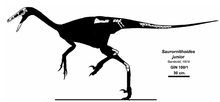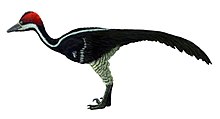Zanabazar junior
| Zanabazar junior | |
|---|---|

| |
| Skeletal restoration of IGM 100/1 | |
| Scientific classification | |
| Domain: | Eukaryota |
| Kingdom: | Animalia |
| Phylum: | Chordata |
| Clade: | Dinosauria |
| Clade: | Saurischia |
| Clade: | Theropoda |
| Family: | †Troodontidae |
| Subfamily: | †Troodontinae |
| Genus: | †Zanabazar Norell et al., 2009 |
| Species: | †Z. junior
|
| Binomial name | |
| †Zanabazar junior | |
| Synonyms | |
| |
Zanabazar is a
History of discovery

The holotype was discovered in 1964 from the Bügiin Tsav locality of the
Description

Zanabazar were large troodontids reaching 2.3 m (7.5 ft) in length and weighing 25 kg (55 lb).[3] They are the largest known Asian troodontids, with a skull length of 27.2 cm (272 mm). At the time of the discovery of the genus, the only other troodontids that appeared to be larger than it were specimens from Alaska,[1] however, Latenivenatrix are now considered the largest troodontids with 3.5 m (11 ft) in length.[4] The preserved vertebrae in IGM 100/1 are completely fused, indicating that this individual was an adult at the time of death.[1]
Classification
While originally included in Saurornithoides, within the

The cladogram below shows the phylogenetic position of Zanabazar among other troodontids following a 2014 analysis.[5]
| Paraves |
| ||||||||||||||||||||||||||||||||||||||||||||||||
See also
References
- ^ hdl:2246/5973.
- ^ a b Barsbold, R. (1974). "Saurornithoididae, a new family of small theropod dinosaurs from Central Asia and North America" (PDF). Palaeontologica Polonica. 30: 5−22.
- ISBN 9780691167664.
- ISSN 0008-4077.
- PMID 24441791.
